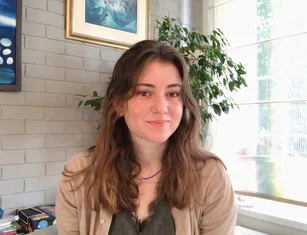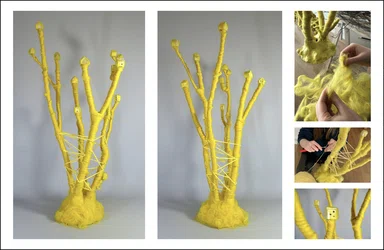




Asli
Soydan
Hisar Education Foundation Schools|Istanbul, Turkey
Teacher: Sevil Tunaboylu
3-D Art and Design

Untitled|24 x 10.2 x 6.6 in.
Material(s): Wooden stick, model house, tree branch, acrylic paint.
Process(es): Painted tree branches. Created structure resembling lampshade-frame, using wooden sticks.

NA|NA
Material(s): Wooden stick, model house, tree branch, acrylic paint.
Process(es): Painted tree branches. Created structure resembling lampshade-frame, using wooden sticks.

Untitled|22.8 x 7 x 7.8 in.
Idea(s): Built houses in a way that no occupant view is blocked and used fewer as the structure ascended.
Material(s): Tree branch, chopstick, air dry ceramic clay, toilet paper, aluminum -Al- foil, liquid glue, flour.
Process(es): Covered Al foil rock with Wc paper dipped in glue/flour mix. Added Tree branches and chopsticks.

... I realized that the shapes and colors surrounding us have a great impact on how we feel. I asked myself: “What kind of houses would I like to see in my city?” I then dreamed I was an architect. I decided to build utopic tree houses and villages to show that aesthetics don’t need to be abandoned to achieve optimum space usage.

Untitled | 22.8 x 7 x 7.8 in
Material(s): Tree branch, chopstick, air dry ceramic clay, toilet paper, aluminum -Al- foil, liquid glue, flour.
Process(es): Covered Al foil rock with Wc paper dipped in glue/flour mix. Added Tree branches and chopsticks
Student statement
Student
statement
I am really grateful for this year’s AP Art and Design journey and would recommend it to any student who is interested because it pushed me to be productive every single day. It helped me cope during a year of quarantine and put me in self-discipline. Once I did my research, drew sketches, and could clearly visualize my models, building the treehouses became a joyful journey of reflecting my dreams.
As Covid swept away the people from the streets of Istanbul, my concentration shifted towards the dark, tall, rectangles. I noticed that the recent buildings are mainly focused on housing the maximum number of people while taking up the least space. This goal takes away the aesthetic look of the buildings, as they appear very cramped and monotone. Feeling more trapped in space and time, I realized that the shapes and colors surrounding us have a great impact on how we feel. I asked myself: “What kind of houses would I like to see in my city?” I then dreamed I was an architect. I decided to build utopic tree houses and villages to show that aesthetics don’t need to be abandoned to achieve optimum space usage. My school did not offer a 3D class, but my friends and family encouraged me to participate, and I think that is partly because we wanted to dream together.
They shared with me the colors they wished to see and the view they wished to watch. This year I learned that making art inspired me much more when I shared my ideas and feelings with my friends and family and listened to them about how they feel when they look at an image, a shape, a color, or a material.
I had my other great inspirations, too. Daisugi, a Japanese forestry technique used to maximize tree plantation, helped me visualize houses that are in connection with nature, creating a feeling of balance. Franz Kafka’s book Metamorphosis gave me the urge to resist gravity just like his main character Samsa. The idea of resisting gravity formed my treehouses and villages to be layered like skyscrapers, but still visually pleasing to the eye. The houses on high levels symbolize my desire to be an onlooker, instead of a participant in the chaos and crowdedness of the city. As I was layering tree branches and wooden materials, I focused on experimenting with different textures and materials, such as wool and ceramic.

Asli Soydan

Untitled | 29 x 15.7 x 16 in.
Material(s): Air dry ceramic clay, yarn, tree branch.
Process(es): Covered tree branches with yarn, stuck them onto a clay platform. Knitted in between the branches.
AP Coordinator
statement
Münevver ÇAVUŞOĞLU
Aslı besides being a very successful student academically, she is also a very talented, dedicated, and diligent art student. Her interests in arts, art history, and modern art, flourished in her junior year. She prepared two different portfolios at the same time for Studio Art. Her sustained investigation on the 3D portfolio was on treehouses in the urban areas. In her portfolio, she created very interesting, utopic tree houses and villages that are layered just like skyscrapers in the cities but they look much softer to society. Daisugi, which is the Japanese forestry technique that maxes the plantation, is the inspiration behind her portfolio. She did not neglect to include her interest in nature and ecology in her works. Her ability to create new ideas and work with different materials proves that she is a true talent and an artist.
Asli Soydan







